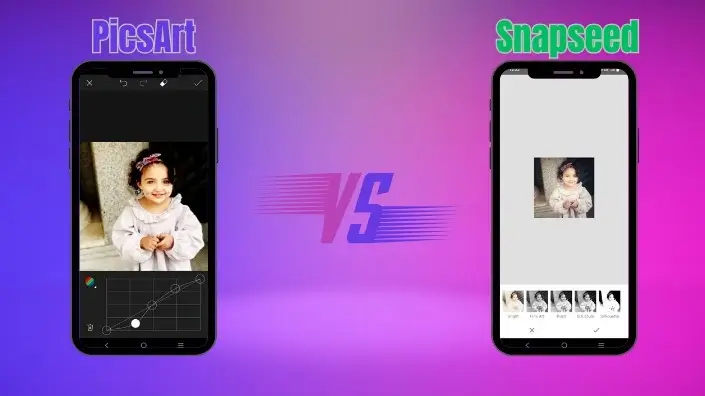PicsArt vs Snapseed: Which Editor is Perfect in 2024

Here, we can discuss two apps PicsArt vs Snapseed. Snapseed is a famous photo-editing app available. This app’s vigorous tools and easy-to-learn filters make editing photos a breeze. A different picture editor steadily moving up the ranks is PicsArt, which offers a ton of excellent editing options along with an easy-to-use UI and some fantastic filters.
It is reasonable to compare the two photo-editing programs and determine which is truly superior.
The common features: PicsArt vs Snapseed
There are a few standard features of PicsArt and Snapseed, which are as follows.
- Tools for Editing
- Modifying Impact Intensity
- Presets and Filters
- Incorporate Several Effects
The common features: PicsArt vs Snapseed
If you are unhappy with the overall appearance of a filter, editing tools are an excellent approach to correcting an image.
You can play around with a lot of tools in Snapseed for Mac. In addition to the standard tools like Tune, Crop, Perspective, etc., there are additional tools like Heal, Glamour Glow, and Curve.
For those who don’t know, tune aids in adjusting an image’s finer aspects, like brightness, saturation, and white balance. In summary, Snapseed offers many features that enable you to personalize the appearance and tone of your photo. Let me say that again.
The Tools section of PicsArt mod apk is a little different and more constrained. Standard editing tools, such as perspective, shape correction, and cropping, are available. While it has some functional capabilities, such as Shape Crop, Curve Motion, and Dispersion, they are less advanced than those in Snapseed.
Modifying Impact Intensity: PicsArt vs Snapseed
Because it offers professional-level tools for even minor tweaks, Snapseed is more of a power user tool. This implies that you will have to delve into the dark waters of color and saturation adjustment if you want to lessen the effect of a filter, and that’s only the beginning.
If you have the time to modify a photo before uploading it, that’s acceptable. On the other hand, it might only sometimes be possible for a bit of work.
Interestingly, PicsArt allows you to change a filter’s intensity directly from the Effects tab.
Applying the filter is all it takes. To adjust the intensity, tap the filter symbol once more.
The fact that each filter has a separate intensity level is the finest thing about this function.
In summary, PicsArt attempts to compensate for the absence of appropriate editing capabilities with many intensity features.
Presets and Filters: PicsArt vs Snapseed
The first point of comparison must, of course, be filters—more specifically, the number of filters supported by each program and their accessibility.
Google added several filters and upgraded its Snapseed software towards the end of the previous year. These eleven presets, dubbed Styles, are logically placed in a row, so you won’t have to sift through lengthy rows of filters when you open a picture to edit. These filters, however restricted, enable you to portray a variety of moods, from sepia to traditional black and white.
With PicsArt, you can enhance your photographs with abundant presets, unlike Snapseed’s restricted selection of filters. You can get everything from basic black and white to artsy filters like Prisma. It also lets you play around with contemporary pixelated and color-gradient filters.
The most prominent feature of PicsArt’s filters is their categorization, which eliminates the need to sift through a vast selection to discover the one you want. Selecting the appropriate category and tapping on the desired filter are all required.
Incorporate Several Effects
Recall the well-known proverb, “Together, we can accomplish so much more than we can alone.” The proverb also applies to filters. Using numerous filters can enhance an image’s appearance significantly. Fortunately, you can apply several filters to photographs using each of these programs.
Snapseed allows you to apply two filters on top of each other without changing anything. Interestingly, to achieve this in PicsArt, you must press on the multiple filters symbol, consisting of two tiny square-shaped icons.
The good news is that the Undo button makes it simple to undo these consequences.
The uncommon features: PicsArt vs Snapseed
There are a few uncommon features in PicsArt APK vs Snapspeed APK, which are as follows.
- RAW Assistance
- Selective and Adjustment
- Once More, Filter Effects
- Portrait
- Changing Backgrounds
RAW Assistance: PicsArt vs Snapseed

Support for RAW picture files is one of the main distinctions between the two applications. Unfortunately, PicsArt does not currently enable RAW editing, but Snapseed does allow you to edit RAW photographs.
Dedicated photographers will concur that one of the first stages in image processing is to shoot in RAW. Thus, it’s a plus if the image editing software you’ve selected allows you to edit RAW photos directly from your phone without requiring you to move them to your computer.
Selective Adjustment: PicsArt vs Snapseed
Sometimes, an image only requires a light touch-up with the edit brush in select areas. It may manifest as brightness, contrast, or exposure. Thankfully, Snapseed is handling this problem seriously.
You can choose a section of an image and alter it appropriately using the Brush and Selective Adjustment tools. Additionally, you have manual control over the focus area.

Once More, Filter Effects : PicsArt vs Snapseed

You may apply a filter to a section of an image with PicsArt, unlike many other programs that allow you to use a filter for the entire image. This gives the picture an excellent mood and a dual-effect aspect.
Conversely, Snapseed distinctly approaches the matter. There is no way to change the intensity of the filters or Snapseed remove object from a particular image region; they are applied to the entire picture.
Portrait: PicsArt and Snapseed
Snapseed includes a ton of tools, but one in particular sticks out. This software offers two uniquely created filters and effects to enhance your portrait photos: Head Pose and Portrait.
The most astounding feature is that the built-in face recognition system automatically identifies the subject and recommends a suitable preset.
Changing Backgrounds: PicsArt and Snapseed

Changing backgrounds is one of PicsArt’s primary functions. That is easily accomplished even though there isn’t a direct tool. To get started, simply make a sticker with the subject and save it.
After finding a suitable background, you only need to import the sticker. The good news is that the program can recognize faces and portraits with enough intelligence to crop the image appropriately.
Unlike the last example, Snapseed does not provide a dedicated technique for quickly snapseed remove background from another image. You can only use it to make a particular image’s backdrop darker or lighter.
Which one do you use?
These were a few of the primary distinctions between PicsArt and Snapseed. It’s important to note that both programs have many other options besides those mentioned above, such as Frames, Double Exposure, and Lens Blur effects.
Ultimately, the dilemma remains the same: which one should I pick? Snapseed is the best option if you plan to do some heavy photo editing. They have many tools and primary effects that allow them to alter the image’s tone.
But you can give PicsArt a go if you’re looking for some impromptu editing with amusing pre-made effects and frames tossed in. However, if I were you, I would support it.





